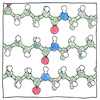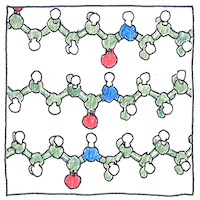Wallace Carothers
materials science

|
Nylon
In 1928, DuPont wooed Corothers from Harvard to work at their Experimental Station on the synthesis of heavy polymers with the hope of producing synthetic materials. In 1930, Arnold Collins on Corother’s staff isolated chloroprene, the liquid precursor to the first synthetic rubber, Neoprene. Carothers developed the theory for polymerizing condensation polymers such as polyesters and polyamides. In 1934 Corothers started working with polyamides, which were more stable than polyesters, with the hope of producing a synthetic silk. In 1935 Gerard Berchet on Corother’s staff produced a small amount of polyamide 6-6, which became known as Nylon.
Parachutes and nylons
Before World War II, parachutes were made with Asian silk and hemp, tents and ropes were made of hemp or cotton, fishing line was made of silk or horsehair, toothbrush bristles were plucked from horse or boar, and guitar strings were made of catgut. DuPont introduced nylon stockings at the 1939 New York World’s Fair, and, during the forties, stockings and pantyhose came to be known as nylons. Before the war, most nylon fibers were made into stockings. During the war, women donated their nylons to be melted down and respun to make parachutes for the war effort.
Polymers
cellulose shellac amber wool silk rubber Bakelite Lucite® Butacite® Corian® Rayon Freon® Nylon Dacron® Orlon® Teflon® Zylon® Spandex® Kevlar® Tyvek® Neoprene Newon☺ Bestiff☺ Funnable☺ Joyite☺ Hopelar☺ Loveine☺



Carothers evaluated over eighty polyamides before chosing nylon 6-6, so named because diamine and diacid each contribute 6 carbons to the polymer chain. DuPont chose not to register “Nylon” as a trademark.
The names in the first list above are natural polymers, in the second, commercial, and, in the third, names for imaginary polymers that I invented.
See also in The book of science:
Readings in wikipedia: